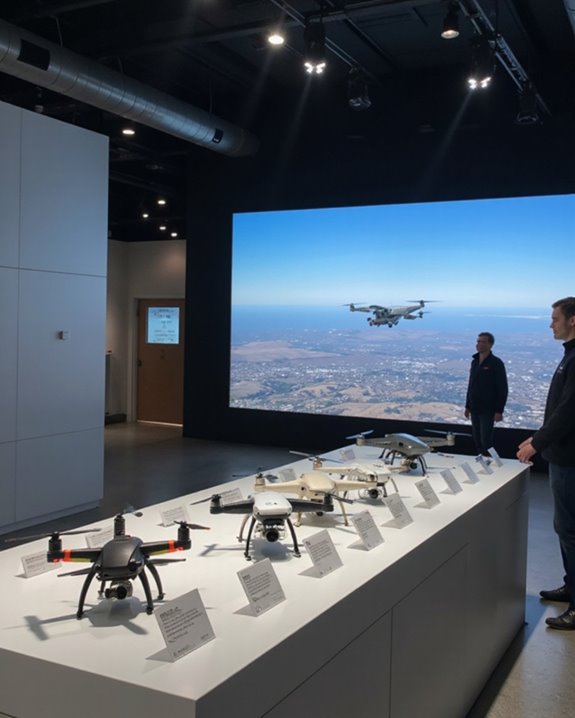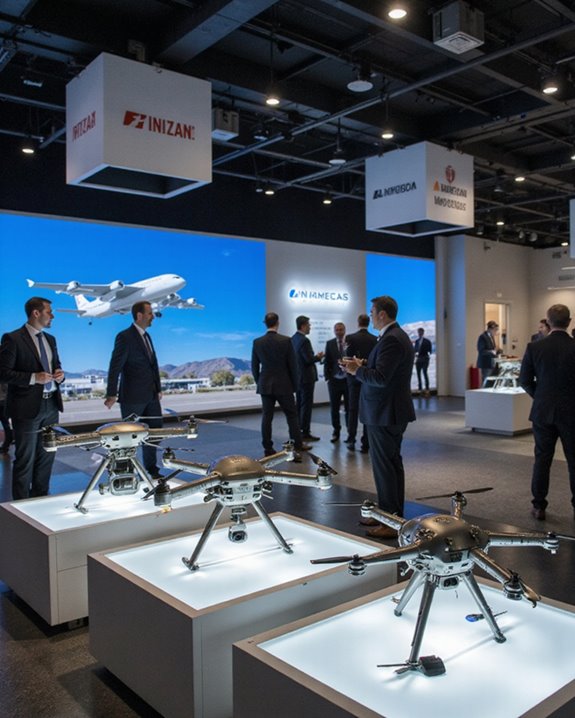Amazon is definitely testing drones for delivery, and not just in a backyard—these aren’t your typical remote-controlled toys! With FAA approval for beyond-visual-line-of-sight flights, Amazon’s MK30 drone flies autonomously with a fancy onboard detect-and-avoid system, dodging obstacles midair. They’ve been buzzing around Texas and Arizona, even planning UK and Italy launches soon. Keen on how they manage battery swaps and cushion your parcels? Keep following along to uncover the smart details behind Prime Air’s sky-high deliveries!
Key Takeaways
- Amazon received FAA approval for beyond-visual-line-of-sight drone flights starting in 2020.
- The MK30 drone, tested by Amazon, features detect-and-avoid technology for safe obstacle navigation.
- Testing includes FAA-supervised flights near hot air balloons to validate drone safety systems.
- Amazon operates drone deliveries in College Station, Texas, and plans expansions in California and Arizona.
- Home delivery trials with drones are planned in the UK and Italy by the end of 2024.
Overview of Amazon’s FAA Approval for Drone Flights
Amazon’s journey into drone delivery took a giant leap forward when it snagged FAA approval for beyond visual line of sight (BVLOS) flights back in 2020. This FAA approval wasn’t just a rubber stamp—it allowed drones to fly farther, beyond the pilot’s direct sight, opening up deliveries to more U.S. locations, including busy neighborhoods. Safety was key, so Amazon developed a sophisticated detect and avoid system, which helps drones dodge obstacles and other aircraft. This system underwent rigorous testing, with heaps of data sent to the FAA to prove it works. The MK30 drone, for example, got the green light for longer flights beyond visual range, showing Amazon’s serious commitment. Plus, waivers for places like Tolleson, Arizona, and College Station, Texas, expanded where these drone deliveries can buzz around—pretty exciting, right? These drones incorporate GPS auto-return and level-5 wind resistance to ensure reliable and safe operation during deliveries.
Development and Features of Amazon’s Drone Technology
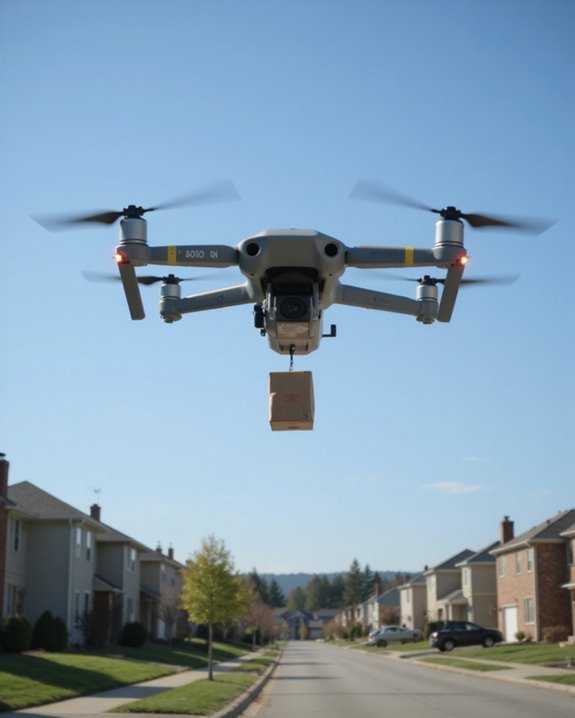
When it comes to making drones smarter and safer, the technology behind these flying delivery pals is nothing short of impressive. Amazon’s Prime Air has been developing advanced drones, like the MK30, which is smaller, quieter, and can fly through light rain—perfect for speedy deliveries! This drone offers twice the range of earlier models, promising to zoom your package faster than ever. Over several years, Amazon built an onboard detect-and-avoid system, helping drones dodge airplanes and helicopters mid-flight. The Federal Aviation Administration has closely supervised tests, including flights near hot air balloons, to guarantee everything meets strict safety rules. With all these upgrades planned for the MK30 to replace the MK27 by late 2024, Amazon’s delivery drones are on track to become even smarter and more reliable! These drones aim to provide 30-90 minutes of flight time using extended battery configurations for rapid package transport.
Locations and Timeline for Prime Air Deliveries

The future of package delivery is taking flight in places like College Station, Texas, where drone operations have been buzzing since 2022 and are set to grow even more by late 2024. Amazon’s Prime Air Drone program is expanding rapidly, soon reaching Lockeford, California, and kicking off in Tolleson, Arizona, with advanced MK30 drones after FAA approval. But that’s not all—drone deliveries will also soar across the pond, launching home deliveries in the UK and Italy by the end of 2024! These locations mark exciting milestones in Amazon’s quest to make packages arrive faster than ever. So, whether you’re in Texas or Tuscany, expect your next delivery might just come with a little buzz from above!
Behind the Scenes: How Amazon’s Drone Deliveries Work
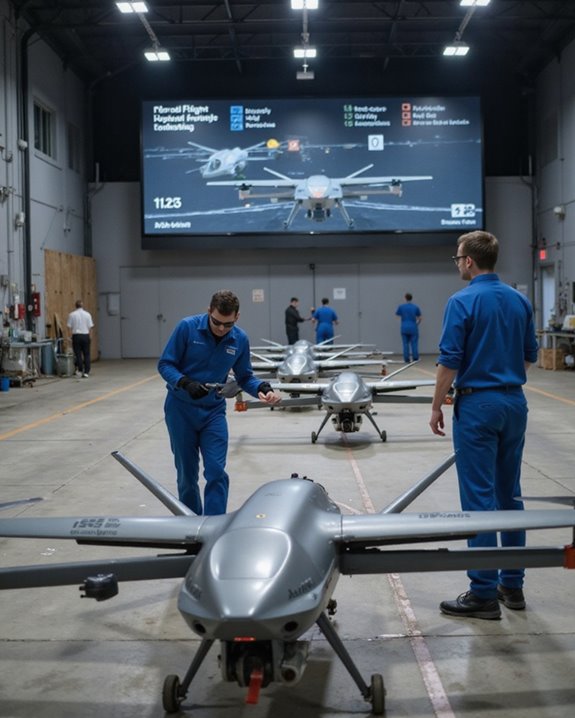
Ever wondered what it takes to send a package flying through the sky, safely landing right at your doorstep? Amazon’s drone operations start with delivery drones receiving a fresh battery before every flight—no battery blues here! Each drone undergoes a thorough top-to-bottom inspection to catch any hiccups early. Packages ride in special boxes with “trampoline” cushioning technology, bouncing safely through the air. Once loaded, drones launch 400 feet high under Amazon employee watchful eyes, ensuring smooth takeoff. After delivering packages, these smart drones head back autonomously, landing precisely on their charging pads, ready for the next mission. It’s a high-tech ballet, where each step is carefully choreographed to deliver efficiency, safety, and a touch of magic right to your doorstep!
The History and Evolution of Amazon’s Prime Air Program
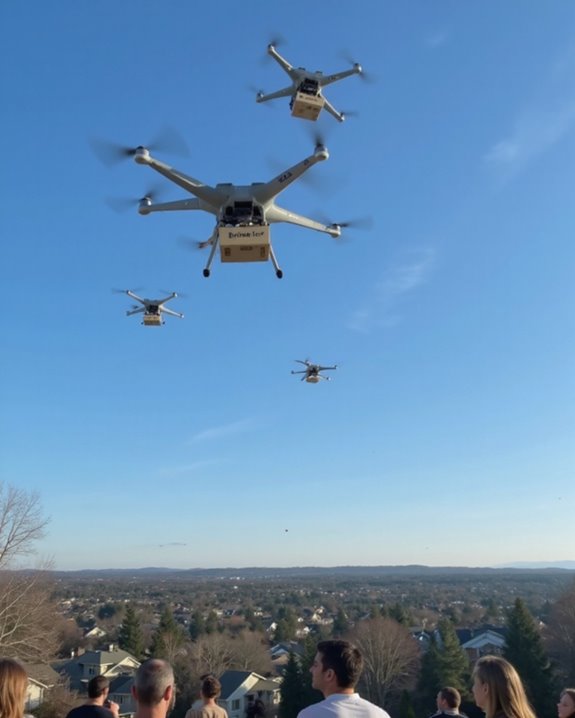
A bold vision for speedy deliveries took flight over a decade ago, thanks to Jeff Bezos and his dream of drones buzzing packages straight to your door. Amazon’s Prime Air program started with high hopes but stumbled over regulatory approval challenges and missed deadlines. The first commercial drone delivery in Cambridge, England, nearly eight years ago, was a thrilling milestone. Since then, Prime Air has grown, earning an FAA Air Carrier Certificate in 2020, allowing flights beyond the usual visual line of sight. Under new leadership, the program plans to swap out the MK27 for a new drone, the MK30, by 2024, promising faster and more efficient deliveries. Despite some setbacks, Prime Air’s evolution shows that the future of drone delivery is closer than you think!
Challenges and Competition in the Drone Delivery Market
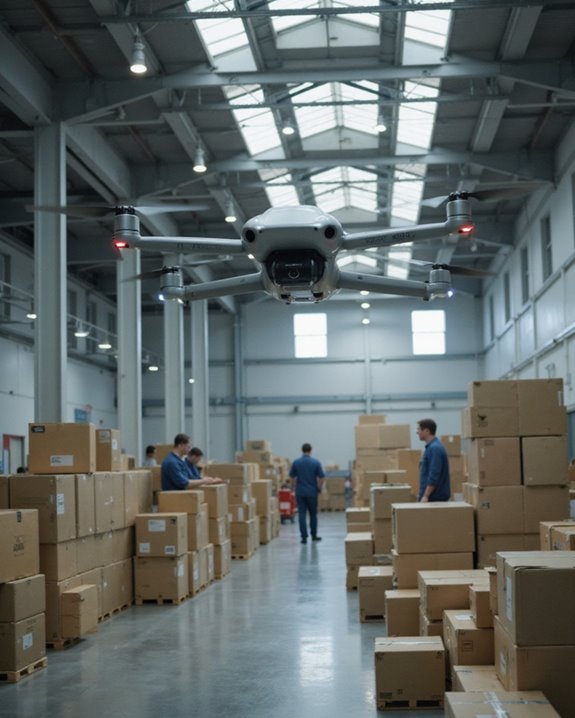
Amazon’s Prime Air may be ready to upgrade its drones, but it’s not flying solo in the race for the skies. Granted Amazon faces stiff competition from Wing, UPS, Walmart, and others like Zipline and Matternet, each chasing their own drone delivery dreams. Last year, setbacks hit Prime Air hard—layoffs and the departure of key FAA contacts slowed progress. Plus, noise complaints in College Station, Texas, mean Amazon must rethink delivery sites by October 2025. Despite these challenges, the drone delivery market is buzzing with innovation and competition, pushing each player to earn their green light from regulators. So, while Amazon aims high, it’s clear the skies are crowded—and only the most agile will soar! Among these advances, drones like the Radiolink M435 demonstrate the potential for heavy lift capabilities with payloads up to 3KG and speeds reaching 120km/h.
Insights From UK Civil Aviation Authority Drone Trials

Drone trials led by the UK Civil Aviation Authority are turning heads in the world of delivery innovation! These tests push drone operations beyond the human controller’s line of sight, tackling tricky tasks like package delivery and emergency supplies. Amazon gets a front-row seat in this high-tech show, testing home deliveries alongside other big projects like windfarm inspections and police support. The drones navigate using advanced visual and electronic systems, spotting and avoiding other aircraft smoothly. Safety is no joke here—communication with air traffic control and controlled environments keep every flight secure. By joining these trials, Amazon gathers vital data via drone tests, aiming to launch commercial home deliveries in the UK by 2024’s end. It’s like watching the future fly right before your eyes!
Career Opportunities in Drone Technology and Operations

Explore exciting career paths in drone technology and operations, where innovation meets opportunity! Vaughn College offers specialized programs to help you make drone dreams a reality, including a UAS Design, Application, and Operation Certificate. With drone engineers and pilots in high demand—and some earning over $100,000 annually—this field is buzzing with potential. Before diving in, be sure to review the terms of use and privacy policy on Vaughn’s website, especially when filling out contact forms to connect with admissions counselors. Whether you want to design sleek drones or pilot them for delivery services, the options are vast. So, if you’re ready to launch a career as thrilling as the drones themselves, Vaughn College is a great place to start your journey!
Frequently Asked Questions
Is Amazon Going to Use Drones for Delivery?
Amazon’s feasibility study confirms drone delivery viability, addressing regulatory hurdles through FAA approvals. Tech innovations like MK30 drones enhance performance, while public perception remains cautiously optimistic, supporting the company’s strategic expansion of drone delivery services in multiple regions.
Where Is Amazon Testing Drones?
When it comes to testing sites, Amazon leaves no stone unturned; location analysis guides area selection. Drone zones include College Station, Texas; Lockeford, California; Tolleson, Arizona; plus the UK and Italy for expanding trials.
What Online Company Is Using Drones to Deliver Packages?
Several online companies use drones for deliveries, including Amazon with Prime Air, Google Wing, FedEx Trials, UPS Innovations, and Alibaba Aerial. These initiatives demonstrate industry’s growing commitment to aerial package transportation and rapid last-mile delivery solutions.
Will Drones Be Used for Delivery?
Like a bird breaking dawn, drones face regulatory challenges, safety concerns, environmental impact, and technological hurdles before widespread delivery use. Despite obstacles, advancements suggest drones will increasingly transform parcel delivery in the near future.



